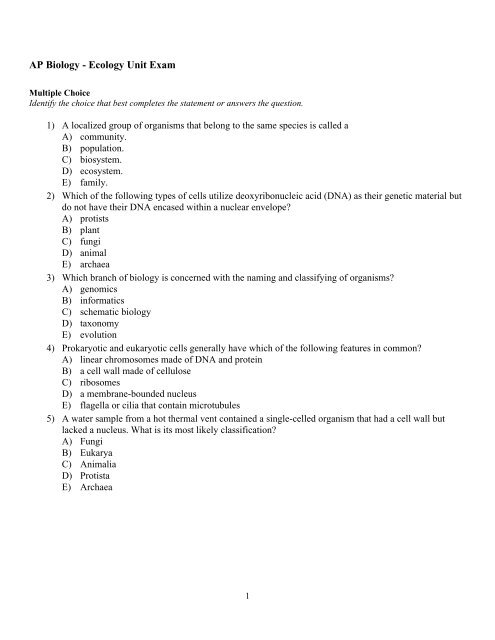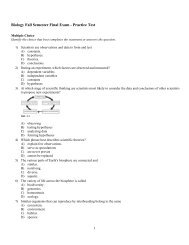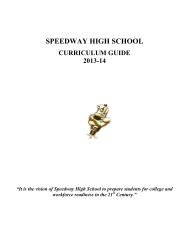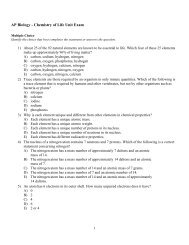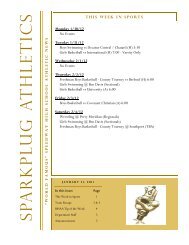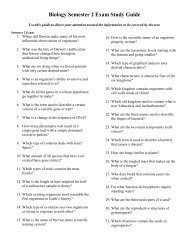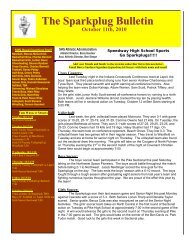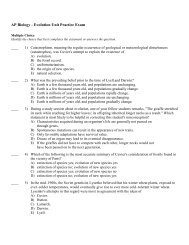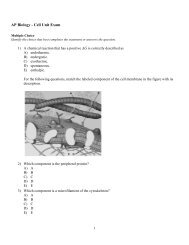ExamView - 2011-2012 AP Ecology Unit Exam.tst - AP Biology
ExamView - 2011-2012 AP Ecology Unit Exam.tst - AP Biology
ExamView - 2011-2012 AP Ecology Unit Exam.tst - AP Biology
You also want an ePaper? Increase the reach of your titles
YUMPU automatically turns print PDFs into web optimized ePapers that Google loves.
<strong>AP</strong> <strong>Biology</strong> - <strong>Ecology</strong> <strong>Unit</strong> <strong>Exam</strong><br />
Multiple Choice<br />
Identify the choice that best completes the statement or answers the question.<br />
1) A localized group of organisms that belong to the same species is called a<br />
A) community.<br />
B) population.<br />
C) biosystem.<br />
D) ecosystem.<br />
E) family.<br />
2) Which of the following types of cells utilize deoxyribonucleic acid (DNA) as their genetic material but<br />
do not have their DNA encased within a nuclear envelope?<br />
A) protists<br />
B) plant<br />
C) fungi<br />
D) animal<br />
E) archaea<br />
3) Which branch of biology is concerned with the naming and classifying of organisms?<br />
A) genomics<br />
B) informatics<br />
C) schematic biology<br />
D) taxonomy<br />
E) evolution<br />
4) Prokaryotic and eukaryotic cells generally have which of the following features in common?<br />
A) linear chromosomes made of DNA and protein<br />
B) a cell wall made of cellulose<br />
C) ribosomes<br />
D) a membrane-bounded nucleus<br />
E) flagella or cilia that contain microtubules<br />
5) A water sample from a hot thermal vent contained a single-celled organism that had a cell wall but<br />
lacked a nucleus. What is its most likely classification?<br />
A) Fungi<br />
B) Eukarya<br />
C) Animalia<br />
D) Protista<br />
E) Archaea<br />
1
6) Charles Darwin proposed a mechanism for descent with modification that stated that organisms of a<br />
particular species are adapted to their environment when they possess<br />
A) non-inheritable traits that enhance their survival in the local environment.<br />
B) non-inheritable traits that enhance their survival and reproductive success in the<br />
local environment.<br />
C) non-inheritable traits that enhance their reproductive success in the local<br />
environment.<br />
D) inheritable traits that decrease their survival and reproductive success in the local<br />
environment.<br />
E) inheritable traits that enhance their survival and reproductive success in the local<br />
environment.<br />
7) Why is Darwin considered original in his thinking?<br />
A) He proposed the mechanism that explained how evolution takes place.<br />
B) He observed that organisms produce large numbers of offspring.<br />
C) He provided examples of organisms that had evolved over time.<br />
D) He described the relationship between genes and evolution.<br />
E) He demonstrated that evolution is continuing to occur now.<br />
8) Which of the following categories of organisms is least likely to be revised?<br />
A) species<br />
B) phylum<br />
C) order<br />
D) kingdom<br />
E) class<br />
9) Collecting data based on observation is an example of _____; analyzing this data to reach a conclusion<br />
is an example of _____ reasoning.<br />
A) hypothesis-based science; deductive<br />
B) descriptive science; deductive<br />
C) discovery science; inductive<br />
D) the process of science; deductive<br />
E) hypothesis-based science; inductive<br />
10) A controlled experiment is one in which<br />
A) the experiment is repeated many times to ensure that the results are accurate.<br />
B) there are at least two groups, one differing from the other by two or more<br />
variables.<br />
C) there is one group for which the scientist controls all variables.<br />
D) the experiment proceeds at a slow pace to guarantee that the scientist can<br />
carefully observe all reactions and process all experimental data.<br />
E) there are at least two groups, one of which does not receive the experimental<br />
treatment.<br />
2
11) The application of scientific knowledge for some specific purpose is known as<br />
A) deductive science.<br />
B) anthropologic science.<br />
C) inductive science.<br />
D) pure science.<br />
E) technology.<br />
12) Which of the following are qualities of any good scientific hypothesis?<br />
I. It is testable.<br />
II. It is falsifiable.<br />
III. It produces quantitative data.<br />
IV. It produces results that can be replicated.<br />
A) II only<br />
B) I only<br />
C) III only<br />
D) I and II<br />
E) III and IV<br />
13) All the organisms on your campus make up<br />
A) an experimental group.<br />
B) a taxonomic domain.<br />
C) an ecosystem.<br />
D) a community.<br />
E) a population.<br />
14) Which of the following abiotic factors has the greatest influence on the metabolic rates of plants and<br />
animals?<br />
A) wind<br />
B) water<br />
C) disturbances<br />
D) rocks and soil<br />
E) temperature<br />
15) A certain species of pine tree survives only in scattered locations at elevations above 2,800 m in the<br />
western <strong>Unit</strong>ed States. To understand why this tree grows only in these specific places, an ecologist<br />
should<br />
A) investigate the various biotic and abiotic factors that are unique to high altitude.<br />
B) conclude that lower elevations are limiting to the survival of this species.<br />
C) analyze the soils found in the vicinity of these trees, looking for unique chemicals<br />
that may support their growth.<br />
D) collect data on temperature, wind, and precipitation at several of these locations<br />
for a year.<br />
E) study the anatomy and physiology of this species.<br />
3
16) Species introduced by humans to new geographic locations<br />
A) can outcompete and displace native species for biotic and abiotic resources.<br />
B) increase the diversity and therefore the stability of the ecosystem.<br />
C) are usually successful in colonizing the area.<br />
D) always spread because they encounter none of their natural predators.<br />
E) are always considered pests by ecologists.<br />
17) Two plant species live in the same biome but on different continents. Although the two species are not<br />
at all closely related, they may appear quite similar as a result of<br />
A) gene flow.<br />
B) introgression.<br />
C) allopatric speciation.<br />
D) convergent evolution.<br />
E) parallel evolution.<br />
18) Which lake zone would be absent in a very shallow lake?<br />
A) limnetic zone<br />
B) pelagic zone<br />
C) aphotic zone<br />
D) littoral zone<br />
E) benthic zone<br />
19) Which of the following is characteristic of most terrestrial biomes?<br />
A) a distribution predicted almost entirely by rock and soil patterns<br />
B) vegetation demonstrating vertical layering<br />
C) cold winter months<br />
D) annual average rainfall in excess of 250 cm<br />
E) clear boundaries between adjacent biomes<br />
20) When climbing a mountain, we can observe transitions in biological communities that are analogous to<br />
the changes<br />
A) in biomes at different latitudes.<br />
B) in an ecosystem as it evolves over time.<br />
C) in a community through different seasons<br />
D) at different depths in the ocean.<br />
E) across the <strong>Unit</strong>ed States from east to west.<br />
21) A population is correctly defined as having which of the following characteristics?<br />
I. inhabiting the same general area<br />
II. belonging to the same species<br />
III. possessing a constant and uniform density and dispersion<br />
A) I only<br />
B) III only<br />
C) I and II only<br />
D) II and III only<br />
E) I, II, and III<br />
4
22) Which of the following groups would be most likely to exhibit uniform dispersion?<br />
A) moths, in a city at night<br />
B) dwarf mistletoes, which parasitize particular species of forest tree<br />
C) red squirrels, who actively defend territories<br />
D) lake trout, which seek out cold, deep water high in dissolved oxygen<br />
E) cattails, which grow primarily at edges of lakes and streams<br />
23) Which of the following is the best example of uniform distribution?<br />
A) a cultivated cornfield in the Midwest<br />
B) territorial songbirds in a mature forest during mating season<br />
C) bees collecting pollen in a wildflower meadow<br />
D) snails in an intertidal zone at low tide<br />
E) mushrooms growing on the floor of an old growth forest<br />
24) Which of the following causes populations to shift most quickly from an exponential to a logistic<br />
population growth?<br />
A) decreased death rate<br />
B) removal of predators<br />
C) increased birth rate<br />
D) competition for resources<br />
E) favorable climatic conditions<br />
The following questions refer to Figure 53.3, which depicts the age structure of three populations.<br />
25) Which population(s) is (are) in the process of decreasing?<br />
A) I<br />
B) II<br />
C) III<br />
D) I and II<br />
E) II and III<br />
26) A population's carrying capacity<br />
A) generally remains constant over time.<br />
B) can be accurately calculated using the logistic growth model.<br />
C) may change as environmental conditions change.<br />
D) increases as the per capita growth rate (r) decreases.<br />
E) can never be exceeded.<br />
5
27) Evidence shows that some grasses benefit from being grazed. Which of the following terms would best<br />
describe this plant–herbivore interaction?<br />
A) commensalism<br />
B) parasitism<br />
C) predation<br />
D) mutualism<br />
E) competition<br />
28) Approximately how many kg of carnivore biomass can be supported by a field plot containing 1,000 kg<br />
of plant material?<br />
A) 10,000<br />
B) 100<br />
C) 10<br />
D) 1<br />
E) 1,000<br />
29) In a tide pool, 15 species of invertebrates were reduced to eight after one species was removed. The<br />
species removed was likely a(n)<br />
A) pathogen.<br />
B) keystone species.<br />
C) resource partitioner.<br />
D) herbivore.<br />
E) mutualistic organism.<br />
30) Why are food chains relatively short?<br />
A) Food chain length is ultimately determined by the photosynthetic efficiency of<br />
producers.<br />
B) Top–level feeders tend to be more numerous than lower–trophic–level species.<br />
C) Top–level feeders tend to be small but are capable of conserving more energy.<br />
D) Longer chains are less stable and energy transfer between levels is inefficient.<br />
E) There are only so many organisms that are adapted to feed on other types of<br />
organisms.<br />
31) Why is a pathogen generally more virulent in a new habitat?<br />
A) More pathogens tend to immigrate into newer habitats.<br />
B) Intermediate host species are more motile and transport pathogens to new areas.<br />
C) Pathogens evolve more efficient forms of reproduction in new environments.<br />
D) Hosts in new environments have not had a chance to become resistant to the<br />
pathogen through natural selection.<br />
E) New environments are almost always smaller in area so that transmission of<br />
pathogens is easily accomplished between hosts.<br />
32) According to the equilibrium model of island biogeography, species richness would be greatest on an<br />
island that is<br />
A) large and remote.<br />
B) small and close to a mainland.<br />
C) environmentally homogeneous.<br />
D) large and close to a mainland.<br />
E) small and remote.<br />
6
33) A cow's herbivorous diet indicates that it is a(n)<br />
A) autotroph.<br />
B) decomposer.<br />
C) secondary consumer.<br />
D) producer.<br />
E) primary consumer.<br />
34) Which of the following terms encompasses all of the others?<br />
A) primary consumers<br />
B) herbivores<br />
C) secondary consumers<br />
D) heterotrophs<br />
E) carnivores<br />
35) Which of the following is an example of an ecosystem?<br />
A) All of the brook trout in a 500 hectare 2 river drainage system.<br />
B) A pond and all of the plant and animal species that live in it.<br />
C) The intricate interactions of the various plant and animal species on a savanna<br />
during a drought.<br />
D) The plants, animals, and decomposers that inhabit an alpine meadow.<br />
E) Interactions between all of the organisms and their physical environment in a<br />
tropical rain forest.<br />
36) The major role of detrivores in ecosystems is to<br />
A) return energy lost to the ecosystem by other organisms.<br />
B) recycle chemical nutrients to a form capable of being used by autotrophs.<br />
C) prevent the buildup of the organic remains of organisms, feces, and so on.<br />
D) provide a nutritional resource for heterotrophs.<br />
37) The total biomass of photosynthetic autotrophs present in an ecosystem is known as<br />
A) standing crop.<br />
B) gross primary productivity.<br />
C) net primary productivity.<br />
D) secondary productivity.<br />
E) trophic efficiency.<br />
38) What is the primary limiting factor for aquatic productivity?<br />
A) lack of nutrients<br />
B) herbivores<br />
C) light availability<br />
D) pressure<br />
E) competition<br />
39) Which of the following lists of organisms is ranked in correct order from lowest to highest percent in<br />
production efficiency?<br />
A) mammals, fish, insects<br />
B) insects, mammals, fish<br />
C) fish, insects, mammals<br />
D) mammals, insects, fish<br />
E) insects, fish, mammals<br />
7
40) The amount of chemical energy in consumers' food that is converted to their own new biomass during a<br />
given time period is known as which of the following?<br />
A) standing crop<br />
B) secondary production<br />
C) biomass<br />
D) biomagnification<br />
E) primary production<br />
41) If the flow of energy in an arctic ecosystem goes through a simple food chain, perhaps involving<br />
humans, starting from phytoplankton to zooplankton to fish to seals to polar bears, then which of the<br />
following could be true?<br />
A) Seal meat probably contains the highest concentrations of fat –soluble toxins.<br />
B) Seal populations are larger than fish populations.<br />
C) The fish can potentially provide more food for humans than the seal meat can.<br />
D) Polar bears can provide more food for humans than seals can.<br />
E) The total biomass of the fish is lower than that of the seals.<br />
42) In the nitrogen cycle, the bacteria that replenish the atmosphere with N 2 are<br />
A) nitrifying bacteria.<br />
B) denitrifying bacteria.<br />
C) methanogenic protozoans.<br />
D) nitrogen–fixing bacteria.<br />
E) Rhizobium bacteria.<br />
43) How does phosphorus normally enter ecosystems?<br />
A) rock weathering<br />
B) cellular respiration<br />
C) vulcanism<br />
D) photosynthesis<br />
E) atmospheric phosphorous gas<br />
44) Which of the following statements is correct about biogeochemical cycling?<br />
A) The phosphorus cycle involves the weathering of rocks.<br />
B) The nitrogen cycle involves movement of diatomic nitrogen between the biotic<br />
and abiotic components of the ecosystem.<br />
C) The carbon cycle has maintained a constant atmospheric concentration of CO 2 for<br />
the past million years.<br />
D) The phosphorus cycle involves the recycling of atmospheric phosphorus.<br />
E) The carbon cycle is a localized cycle that primarily involves the burning of fossil<br />
fuels.<br />
45) Why do logged tropical rain forest soils typically have nutrient–poor soils?<br />
A) Nutrients evaporate easily into the atmosphere in the post –logged forest.<br />
B) The cation exchange capacity of the soil is reversed as a result of logging.<br />
C) Most of the nutrients in the ecosystem are removed in the harvested timber.<br />
D) Tropical bedrock contains little phosphorous.<br />
E) Logging results in soil temperatures that are lethal to nitrogen–fixing bacteria.<br />
8
46) What is the first step in ecosystem restoration?<br />
A) to restore the physical structure<br />
B) to remove competitive invasive species<br />
C) to restore native species that have been extirpated due to disturbance<br />
D) to identify the limiting factors of the producers<br />
E) to remove toxic pollutants<br />
47) What is the goal of restoration ecology?<br />
A) to speed up the restoration of a degraded ecosystem<br />
B) to prevent further degradation by protecting an area with park status<br />
C) to completely restore a disturbed ecosystem to its former undisturbed state<br />
D) to replace a ruined ecosystem with a more suitable ecosystem for that area<br />
E) to manage competition between species in human –altered ecosystems<br />
48) Which of the following statements is true?<br />
A) An ecosystem's trophic structure determines the rate at which energy cycles<br />
within the system.<br />
B) There has been a well–documented increase in atmospheric nitrogen over the past<br />
several decades.<br />
C) At any point in time, it is impossible for consumers to outnumber producers in an<br />
ecosystem.<br />
D) Chemoautotrophic prokaryotes near deep–sea vents are primary producers.<br />
E) The reservoir of ecosystem phosphorous is the atmosphere.<br />
49) In a typical grassland community, which of the following has the smallest biomass?<br />
A) hawk<br />
B) grass<br />
C) shrew<br />
D) grasshopper<br />
E) snake<br />
50) Nitrifying bacteria participate in the nitrogen cycle mainly by<br />
A) converting ammonium to nitrate, which plants absorb.<br />
B) converting nitrogen gas to ammonia.<br />
C) converting ammonia to nitrogen gas, which returns to the atmosphere.<br />
D) incorporating nitrogen into amino acids and organic compounds.<br />
E) releasing ammonium from organic compounds, thus returning it to the soil.<br />
9
ID: A<br />
<strong>AP</strong> <strong>Biology</strong> - <strong>Ecology</strong> <strong>Unit</strong> <strong>Exam</strong><br />
Answer Section<br />
MULTIPLE CHOICE<br />
1) ANS: B TOP: Concept 1.1 MSC: Knowledge/Comprehension<br />
BNK: Chapter 1—Introduction: Themes in the Study of Life<br />
2) ANS: B TOP: Concept 1.1 MSC: Application/Analysis<br />
BNK: Chapter 1—Introduction: Themes in the Study of Life<br />
3) ANS: D TOP: Concept 1.1 MSC: Knowledge/Comprehension<br />
BNK: Chapter 1—Introduction: Themes in the Study of Life<br />
4) ANS: C TOP: Concept 1.1 MSC: Knowledge/Comprehension<br />
BNK: Chapter 1—Introduction: Themes in the Study of Life<br />
5) ANS: E TOP: Concept 1.2 MSC: Application/Analysis<br />
BNK: Chapter 1—Introduction: Themes in the Study of Life<br />
6) ANS: E TOP: Concept 1.2 MSC: Knowledge/Comprehension<br />
BNK: Chapter 1—Introduction: Themes in the Study of Life<br />
7) ANS: A TOP: Concept 1.2 MSC: Knowledge/Comprehension<br />
BNK: Chapter 1—Introduction: Themes in the Study of Life<br />
8) ANS: A TOP: Concept 1.2 MSC: Synthesis/Evaluation<br />
BNK: Chapter 1—Introduction: Themes in the Study of Life<br />
9) ANS: C TOP: Concept 1.3 MSC: Application/Analysis<br />
BNK: Chapter 1—Introduction: Themes in the Study of Life<br />
10) ANS: E TOP: Concept 1.3 MSC: Application/Analysis<br />
BNK: Chapter 1—Introduction: Themes in the Study of Life<br />
11) ANS: E TOP: Concept 1.3 MSC: Knowledge/Comprehension<br />
BNK: Chapter 1—Introduction: Themes in the Study of Life<br />
12) ANS: D TOP: Concept 1.3 MSC: Knowledge/Comprehension<br />
BNK: Chapter 1—Introduction: Themes in the Study of Life<br />
13) ANS: D TOP: End–of–Chapter Questions MSC: Knowledge/Comprehension<br />
BNK: Chapter 1—Introduction: Themes in the Study of Life<br />
14) ANS: E TOP: Concept 52.1 MSC: Knowledge/Comprehension<br />
BNK: Chapter 52—An Introduction to <strong>Ecology</strong> and the Biosphere<br />
15) ANS: A TOP: Concept 52.4 MSC: Application/Analysis<br />
BNK: Chapter 52—An Introduction to <strong>Ecology</strong> and the Biosphere<br />
16) ANS: A TOP: Concept 52.4 MSC: Application/Analysis<br />
BNK: Chapter 52—An Introduction to <strong>Ecology</strong> and the Biosphere<br />
17) ANS: D TOP: Concept 52.4 MSC: Knowledge/Comprehension<br />
BNK: Chapter 52—An Introduction to <strong>Ecology</strong> and the Biosphere<br />
18) ANS: C TOP: End–of–Chapter Questions MSC: Knowledge/Comprehension<br />
BNK: Chapter 52—An Introduction to <strong>Ecology</strong> and the Biosphere<br />
19) ANS: B TOP: End–of–Chapter Questions MSC: Application/Analysis<br />
BNK: Chapter 52—An Introduction to <strong>Ecology</strong> and the Biosphere<br />
1
ID: A<br />
20) ANS: A TOP: End–of–Chapter Questions MSC: Application/Analysis<br />
BNK: Chapter 52—An Introduction to <strong>Ecology</strong> and the Biosphere<br />
21) ANS: C TOP: Concept 53.1 MSC: Knowledge/Comprehension<br />
BNK: Chapter 53—Population <strong>Ecology</strong><br />
22) ANS: C TOP: Concept 53.1 MSC: Application/Analysis<br />
BNK: Chapter 53—Population <strong>Ecology</strong><br />
23) ANS: B TOP: Concept 53.1 MSC: Synthesis/Evaluation<br />
BNK: Chapter 53—Population <strong>Ecology</strong><br />
24) ANS: D TOP: Concept 53.3 MSC: Synthesis/Evaluation<br />
BNK: Chapter 53—Population <strong>Ecology</strong><br />
25) ANS: B TOP: Concept 53.6 MSC: Application/Analysis<br />
BNK: Chapter 53—Population <strong>Ecology</strong><br />
26) ANS: C TOP: End–of–Chapter Questions MSC: Knowledge/Comprehension<br />
BNK: Chapter 53—Population <strong>Ecology</strong><br />
27) ANS: D TOP: Concept 54.1 MSC: Knowledge/Comprehension<br />
BNK: Chapter 54—Community <strong>Ecology</strong><br />
28) ANS: C TOP: Concept 54.2 MSC: Application/Analysis<br />
BNK: Chapter 54—Community <strong>Ecology</strong><br />
29) ANS: B TOP: Concept 54.2 MSC: Knowledge/Comprehension<br />
BNK: Chapter 54—Community <strong>Ecology</strong><br />
30) ANS: D TOP: Concept 54.2 MSC: Knowledge/Comprehension<br />
BNK: Chapter 54—Community <strong>Ecology</strong><br />
31) ANS: D TOP: Concept 54.5 MSC: Synthesis/Evaluation<br />
BNK: Chapter 54—Community <strong>Ecology</strong><br />
32) ANS: D TOP: End–of–Chapter Questions MSC: Knowledge/Comprehension<br />
BNK: Chapter 54—Community <strong>Ecology</strong><br />
33) ANS: E TOP: Concept 55.1 MSC: Knowledge/Comprehension<br />
BNK: Chapter 55—Ecosystems and Restoration <strong>Ecology</strong><br />
34) ANS: D TOP: Concept 55.1 MSC: Synthesis/Evaluation<br />
BNK: Chapter 55—Ecosystems and Restoration <strong>Ecology</strong><br />
35) ANS: E TOP: Concept 55.1 MSC: Application/Analysis<br />
BNK: Chapter 55—Ecosystems and Restoration <strong>Ecology</strong><br />
36) ANS: B TOP: Concept 55.1 MSC: Knowledge/Comprehension<br />
BNK: Chapter 55—Ecosystems and Restoration <strong>Ecology</strong><br />
37) ANS: A TOP: Concept 55.2 MSC: Knowledge/Comprehension<br />
BNK: Chapter 55—Ecosystems and Restoration <strong>Ecology</strong><br />
38) ANS: A TOP: Concept 55.2 MSC: Knowledge/Comprehension<br />
BNK: Chapter 55—Ecosystems and Restoration <strong>Ecology</strong><br />
39) ANS: A TOP: Concept 55.2 MSC: Application/Analysis<br />
BNK: Chapter 55—Ecosystems and Restoration <strong>Ecology</strong><br />
40) ANS: B TOP: Concept 55.3 MSC: Knowledge/Comprehension<br />
BNK: Chapter 55—Ecosystems and Restoration <strong>Ecology</strong><br />
41) ANS: C TOP: Concept 55.3 MSC: Application/Analysis<br />
BNK: Chapter 55—Ecosystems and Restoration <strong>Ecology</strong><br />
2
ID: A<br />
42) ANS: B TOP: Concept 55.4 MSC: Knowledge/Comprehension<br />
BNK: Chapter 55—Ecosystems and Restoration <strong>Ecology</strong><br />
43) ANS: A TOP: Concept 55.4 MSC: Knowledge/Comprehension<br />
BNK: Chapter 55—Ecosystems and Restoration <strong>Ecology</strong><br />
44) ANS: A TOP: Concept 55.4 MSC: Knowledge/Comprehension<br />
BNK: Chapter 55—Ecosystems and Restoration <strong>Ecology</strong><br />
45) ANS: C TOP: Concept 55.4 MSC: Synthesis/Evaluation<br />
BNK: Chapter 55—Ecosystems and Restoration <strong>Ecology</strong><br />
46) ANS: A TOP: Concept 55.5 MSC: Knowledge/Comprehension<br />
BNK: Chapter 55—Ecosystems and Restoration <strong>Ecology</strong><br />
47) ANS: A TOP: Concept 55.5 MSC: Knowledge/Comprehension<br />
BNK: Chapter 55—Ecosystems and Restoration <strong>Ecology</strong><br />
48) ANS: D TOP: Concept 55.5 MSC: Knowledge/Comprehension<br />
BNK: Chapter 55—Ecosystems and Restoration <strong>Ecology</strong><br />
49) ANS: A TOP: Concept 55.5 MSC: Application/Analysis<br />
BNK: Chapter 55—Ecosystems and Restoration <strong>Ecology</strong><br />
50) ANS: A TOP: End–of–Chapter Questions MSC: Application/Analysis<br />
BNK: Chapter 55—Ecosystems and Restoration <strong>Ecology</strong><br />
3


